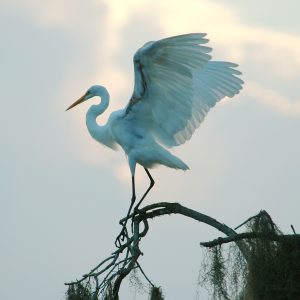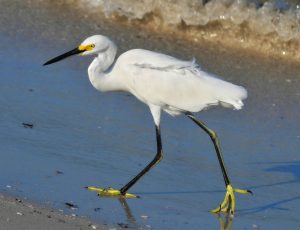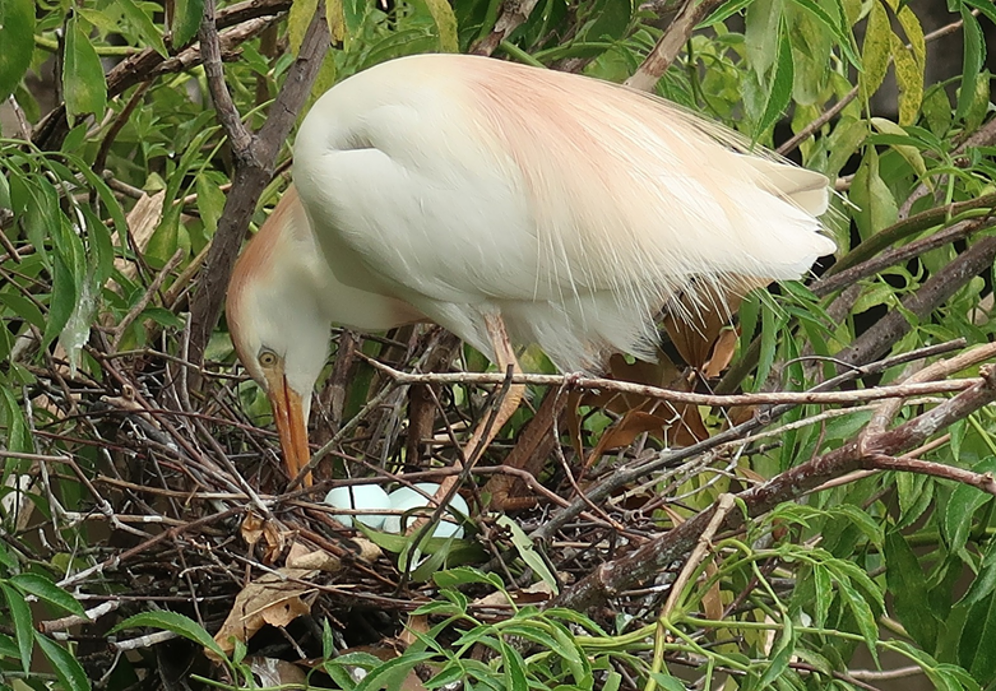It’s a bird, it’s a plane, it’s a…

Is it an egret or a heron? Well, biologically there isn’t much of a difference. Taxonomically, egrets and herons are classified in the same Order and Family, meaning they are very similar. In fact, the Great Egret is more closely related to the Great Blue Heron than any other species of egrets (both being in Genus Ardea). The Snowy and Reddish Egrets are in the same genus as the Little Blue and Tricolored Herons (Genus Egretta). Common names for animal and plant species are often non-specific and can lead to confusion. Egret is often used to define white-feathered species and the name heron is often used for their dark feathered friends, but even this has exceptions.
Read on for a deeper dive about identifying Florida’s engaging egrets, and read more about the plume trade, herons, cranes, and other wading birds in our Wild Sarasota blog series, or watch our Wild Sarasota Webinars on our Florida’s Wildlife webpage for a more in depth exploration of all our wonderful wildlife.
Engaging Egrets

Egrets are medium to large sized birds in Family Ardeida, a family that also includes species of herons and bitterns. Egrets and herons are also part of Order Pelecaniformes, which expands to include ibis, spoonbills, pelicans, shoebills, and the hamerkop (talk about confusing common names!).
Egrets have long, spear-like bills and long legs and feet that are ideal for wading in shallow waters. Well dressed with their once highly desirable plumes, egrets in Florida were once hunted almost to extinction.
There are four different species of egrets that can be found here in Florida.
The Great Egret (Ardea alba)

Most likely you have spotted this elegant, tall, all-white wading bird walking through the wetlands on its long black legs, spearing its prey with it’s long, dagger-like yellow beak. During breeding season, the Great Egret will develop showy, wispy plumes and a patch of its facial skin near the bill will turn from yellow to green.
Maybe you have seen the Great Egret patiently waiting for unsuspecting prey to pass by, or you may have seen their graceful flight patterns. In just two wingbeats per second, the Great Egret soars at a steady speed of 25 miles per hour.
During the Plume Trade of the late 19th and 20th century, over 95% of the Great Egrets in North America were killed for their feathers. Fortunately, with strong conservation efforts and the banning of plume hunting in 1910, the Great Egret population quickly recovered.
The Reddish Egret (Egretta rufescens)

The rarest egret in North America. This wading bird is large, but slightly smaller than the Great Egret. It has a reddish-brown to steel gray plumage with a light colored beak tipped in black.
Unlike the patient and poised Great Egret, this bird puts on quite the show while hunting. The Reddish Egret will pursue its prey either on foot or swoop in on them during flight. They also stir up the sediment with their feet and flare their wings up to startle their prey. Opening their wings will also provide a shaded area that allows the egret to see through the waters glare, this is known as Canopy Feeding. Watching a Reddish egret hunt, it appears as if they are dancing with the wetland and coastal waters in which they feed.
The Snowy Egret (Egretta thula)

Smaller than the Great Egret, the Snowy Egret is a medium sized, white heron with long black legs and bright yellow feet, and bright yellow skin at base of their black bill. During mating season the yellow skin of their feet and face will turn bright orangish to reddish. They have a unique hunting behavior, wriggling their long, yellow toes to entice fish and other small aquatic creatures closer to their demise. This bird can be commonly found along coastal habitats, but is also seen amongst inland freshwater wetlands.
Aigrettes are the long wispy feathers on the back of the Snowy Egrets neck and head that develop during breeding season. Other egrets and herons also develop aigrette feathers during mating season. These plumes were once worth twice the price of gold, valued at $32 per ounce in 1886.
The Western Cattle Egret (Bubulcus ibis):

Originally from Africa, the Western Cattle Egret was brought to South America in 1877 and started breeding in North America in 1953 and is now found throughout the southern half of our country and all of Central and South America. A year-round resident in Florida, it is our smallest egret. They are short and stocky and their neck is shorter and more thick in comparison to other egrets. Their beak, legs, and feet are yellow, but will turn more orange during breeding season.
The Cattle Egret does not only differ in size, but it’s preferred habitat is different from that of other egrets. Find this bird hunting for insects and small animals in fields, lawns, and agricultural areas, as opposed to wetland habitats. They can be found following cattle or farm machinery looking for a tasty meal stirred up by their movement.
Also developing wispy plumes on their head, chest and back during breeding season, this egret’s aigrettes will turn an even more vibrant rusty reddish-brown as it shows off for mates.
To Learn More About Egrets:
- Watch our Wild Sarasota Webinar: Florida’s Egrets and the Story of Audubon, found on our Florida Wildlife webpage
- Enjoy information about a variety of bird species at Cornell Lab of Ornithology’s All About Birds website.
- Don’t forget to visit our local Sarasota Audubon Society and Venice Area Audubon Society.
Read all our Wild Sarasota blogs HERE
 2
2
